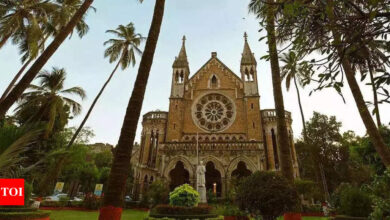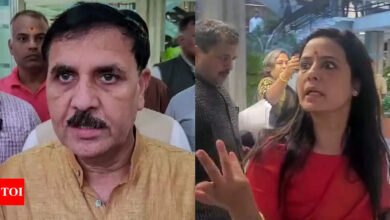India
Remaking history at the cost of India’s heritage | India News

[ad_1]
Cracks developed in the ceiling of Diwan-i Aam at Agra Fort after a G20 event was held there on February 11. Experts have speculated that loud music from speakers installed inside the 17th-century building caused the cracks. But this didn’t deter the Maharashtra government from holding another event at the Unesco World Heritage Site on February 19 to celebrate the birth anniversary of Maratha king Shivaji, who had felt humiliated in the court of emperor Aurangzeb Alamgir, in the same building, back in 1666.
Archaeological Survey of India (ASI), which had originally denied permission for the Shivaji event, clarified that it was held away from the damaged part of the building. But the desire to symbolically avenge Shivaji 357 years after his humiliation seems to have trumped concerns about heritage conservation.
Not The First Time
This has been a perennial problem of Indian heritage conservation. Right at its birth, independent India set out on a journey to ‘right historical wrongs’ when it decided to build a new temple at Somnath in Gujarat, swatting aside opposition from heritage conservationists and archaeologists, and completely dismantling the ruins of the older temple ravaged by invasions and time that contained, to borrow Jawaharlal Nehru’s famous phrase, “palimpsest pasts”.
K M Munshi, who was the prime mover of the bid to rebuild the Somnath Temple and was backed to the hilt by home minister Sardar Patel, acknowledged that the proposal to rebuild the temple drew the ire of archaeologists. “In the beginning, some persons, more fond of dead stonesthan live values, pressed the point of view that the ruins of the old temple should be maintained as an ancient monument. We were, however, firm in our view, that the temple of Somanatha was not an ancient monument; it lived in the sentiment of the whole nation and its reconstruction was a national pledge,” Munshi wrote in his 1951 book, ‘Somanatha: The Shrine Eternal’.
History Before Heritage
Preserving history was not Munshi’s concern, making history was. And he made it amply clear when he said the temple’s “preservation should not be a mere matter of historical curiosity”. He wrote: “Some of my scholar friends had hard things to say about me for my ‘vandalism’. They forgot that I am fond of history, but fonder still of creative values. ”
ASI continued to oppose the move. This resulted in Sardar Patel’s intervention in 1948 when he said (as quoted by Munshi), “…. The Hindu sentiment in regard to this temple is both strong and widespread. In the present conditions, it is unlikely that that sentiment will be satisfied by mere restoration of the templeor by prolonging its life. The restoration of the idol would be a point of honour and sentiment with the Hindu public. ” What was striking in the Somnath episode, as Dutch anthropologist Peter van der Heer observes, was that the opposition of archaeologists and heritage conservationists was described as a “colonial view” that had to be dispensed with as India had become free. The logic of this flowed from the fact that the site was designated an “ancient monument” during the viceroyalty of Lord Curzon (1899-1905) – a stunning inversion of the decolonisation argument.
Curzon’s Forgotten Work
Lord Curzon, mostly reviled by Indian nationalists as the man who partitioned Bengal, had a rather positive contribution to Indian archaeology. He organised both conservation and restoration works at various Indian monuments, including the Taj Mahal and the fort at Agra, and the Red Fort in Delhi. A plaque at one of Shah Jahan’s buildings at Agra Fort still commemorates Curzon’s contribution. He came down hard on the practice of whitewashing and plastering monuments. The plastering work done at Diwan-i Aam at Agra Fort displeased him when he visited it in 1899. The viceroy was told that plastering was done to preserve the integrity of the stonework that had decayed. Curzon demanded that repainting work be stopped and the building preserved in an ‘as is where is’ state. He was also displeased to find that the ceilings of both the Diwan-i Aam and Diwan-i Khas at Delhi’s Red Fort were being repainted, and thought the work was “uniformly bad”.
Curzon outlined his conservation philosophy in Indian Archaeology: “Better the perished and faded originals than a series of modern restorations. ”Curzon got some of the missing tilework behind the Mughal throne at Delhi’s Diwan-i Aam installed. It had been taken away during the loot of 1857. He got an Italian craftsman to travel to Delhi to make substitutes for the missing panels as a Venetian craftsman named Austin de Bordeaux had made the originals for emperor Shah Jahan.
But Curzon’s more lasting impact was the landscaping of the Mughal gardens at the Taj and at Red Fort in Delhi that became a template for all subsequent heritage works in the subcontinent. The Delhi works were done for the 1903 Durbar. When the Durbar of 1911 was organised by viceroy Lord Hardinge, he had Curzon’s model to follow. “The fort at Delhi which had been a wilderness was sparkling with fountains, water runnels, green lawns and shrubberies…” Hardinge wrote in his 1948 memoir, ‘My Indian Years, 1910-1916’. The 1911 Durbar was quite the statement in imperial pomp and pageantry and had the Mughal citadel as its centrepiece. King George V and Queen Mary made an appearance before the public from the ramparts of the Mughal palace complex, mimicking the jharokha darshan of the Mughal emperors of yore. But it was lambasted by Indian nationalists, who had much to suspect about the British intent.
Rules Made, Then Flouted
Historian Julie Codell writes that all three durbars (1877, 1903, 1911) had their trenchant critics in the Indian press:“The radical Amrita Bazar Patrika described the viceroy’s speech as ‘full of the usual platitudes’. The Bombay Gazette opposed the Durbar due to excessive costs. The Bengalee asked, ‘What has Lord Curzon done to revive the industries in British India?’ The Hindoo Patriot called the 1903 Durbar ‘an extravagant waste’ and considered its exhibition merely a ‘symbol of Britain’s power and glory in the East’. The Anglo-Indian Statesman praised the exhibition, then criticised it as ‘a glorified bazaar’ in which a ‘European mind supplies the outline, the measurement, the broad character; Oriental ingenuity and fancy are confined to the ornament’,” Codell writes in ‘On the Delhi Coronation Durbars, 1877, 1903, 1911’.
Challenges to heritage conservation kept coming in postcolonial India too. In 1997, renowned composer Yanni held a concert with the Taj Mahal as the backdrop, drawing howls of protests from environmentalists and heritage conservationists who argued that loud music might impact the 17th-century mausoleum and bright lighting might attract bugs whose excrement could corrode its marble. The concert went ahead as planned with court help, but the tomb was found littered with bugs the following morning, proving conservationists’ fears right. This resulted in the Supreme Court imposing certain conditions for noise and light levels around the monument. But not many lessons were learnt as the UP government a few years later locked horns with the ASI to illuminate the Taj for the ‘Taj Mahotsav’ festival.
The recent incident at the Agra Fort only shows why protecting heritage is a tough battle in India.
The writer is a journalist doing his PhD in history at the University of British Columbia, Canada.
Archaeological Survey of India (ASI), which had originally denied permission for the Shivaji event, clarified that it was held away from the damaged part of the building. But the desire to symbolically avenge Shivaji 357 years after his humiliation seems to have trumped concerns about heritage conservation.
Not The First Time
This has been a perennial problem of Indian heritage conservation. Right at its birth, independent India set out on a journey to ‘right historical wrongs’ when it decided to build a new temple at Somnath in Gujarat, swatting aside opposition from heritage conservationists and archaeologists, and completely dismantling the ruins of the older temple ravaged by invasions and time that contained, to borrow Jawaharlal Nehru’s famous phrase, “palimpsest pasts”.
K M Munshi, who was the prime mover of the bid to rebuild the Somnath Temple and was backed to the hilt by home minister Sardar Patel, acknowledged that the proposal to rebuild the temple drew the ire of archaeologists. “In the beginning, some persons, more fond of dead stonesthan live values, pressed the point of view that the ruins of the old temple should be maintained as an ancient monument. We were, however, firm in our view, that the temple of Somanatha was not an ancient monument; it lived in the sentiment of the whole nation and its reconstruction was a national pledge,” Munshi wrote in his 1951 book, ‘Somanatha: The Shrine Eternal’.
History Before Heritage
Preserving history was not Munshi’s concern, making history was. And he made it amply clear when he said the temple’s “preservation should not be a mere matter of historical curiosity”. He wrote: “Some of my scholar friends had hard things to say about me for my ‘vandalism’. They forgot that I am fond of history, but fonder still of creative values. ”
ASI continued to oppose the move. This resulted in Sardar Patel’s intervention in 1948 when he said (as quoted by Munshi), “…. The Hindu sentiment in regard to this temple is both strong and widespread. In the present conditions, it is unlikely that that sentiment will be satisfied by mere restoration of the templeor by prolonging its life. The restoration of the idol would be a point of honour and sentiment with the Hindu public. ” What was striking in the Somnath episode, as Dutch anthropologist Peter van der Heer observes, was that the opposition of archaeologists and heritage conservationists was described as a “colonial view” that had to be dispensed with as India had become free. The logic of this flowed from the fact that the site was designated an “ancient monument” during the viceroyalty of Lord Curzon (1899-1905) – a stunning inversion of the decolonisation argument.
Curzon’s Forgotten Work
Lord Curzon, mostly reviled by Indian nationalists as the man who partitioned Bengal, had a rather positive contribution to Indian archaeology. He organised both conservation and restoration works at various Indian monuments, including the Taj Mahal and the fort at Agra, and the Red Fort in Delhi. A plaque at one of Shah Jahan’s buildings at Agra Fort still commemorates Curzon’s contribution. He came down hard on the practice of whitewashing and plastering monuments. The plastering work done at Diwan-i Aam at Agra Fort displeased him when he visited it in 1899. The viceroy was told that plastering was done to preserve the integrity of the stonework that had decayed. Curzon demanded that repainting work be stopped and the building preserved in an ‘as is where is’ state. He was also displeased to find that the ceilings of both the Diwan-i Aam and Diwan-i Khas at Delhi’s Red Fort were being repainted, and thought the work was “uniformly bad”.
Curzon outlined his conservation philosophy in Indian Archaeology: “Better the perished and faded originals than a series of modern restorations. ”Curzon got some of the missing tilework behind the Mughal throne at Delhi’s Diwan-i Aam installed. It had been taken away during the loot of 1857. He got an Italian craftsman to travel to Delhi to make substitutes for the missing panels as a Venetian craftsman named Austin de Bordeaux had made the originals for emperor Shah Jahan.
But Curzon’s more lasting impact was the landscaping of the Mughal gardens at the Taj and at Red Fort in Delhi that became a template for all subsequent heritage works in the subcontinent. The Delhi works were done for the 1903 Durbar. When the Durbar of 1911 was organised by viceroy Lord Hardinge, he had Curzon’s model to follow. “The fort at Delhi which had been a wilderness was sparkling with fountains, water runnels, green lawns and shrubberies…” Hardinge wrote in his 1948 memoir, ‘My Indian Years, 1910-1916’. The 1911 Durbar was quite the statement in imperial pomp and pageantry and had the Mughal citadel as its centrepiece. King George V and Queen Mary made an appearance before the public from the ramparts of the Mughal palace complex, mimicking the jharokha darshan of the Mughal emperors of yore. But it was lambasted by Indian nationalists, who had much to suspect about the British intent.
Rules Made, Then Flouted
Historian Julie Codell writes that all three durbars (1877, 1903, 1911) had their trenchant critics in the Indian press:“The radical Amrita Bazar Patrika described the viceroy’s speech as ‘full of the usual platitudes’. The Bombay Gazette opposed the Durbar due to excessive costs. The Bengalee asked, ‘What has Lord Curzon done to revive the industries in British India?’ The Hindoo Patriot called the 1903 Durbar ‘an extravagant waste’ and considered its exhibition merely a ‘symbol of Britain’s power and glory in the East’. The Anglo-Indian Statesman praised the exhibition, then criticised it as ‘a glorified bazaar’ in which a ‘European mind supplies the outline, the measurement, the broad character; Oriental ingenuity and fancy are confined to the ornament’,” Codell writes in ‘On the Delhi Coronation Durbars, 1877, 1903, 1911’.
Challenges to heritage conservation kept coming in postcolonial India too. In 1997, renowned composer Yanni held a concert with the Taj Mahal as the backdrop, drawing howls of protests from environmentalists and heritage conservationists who argued that loud music might impact the 17th-century mausoleum and bright lighting might attract bugs whose excrement could corrode its marble. The concert went ahead as planned with court help, but the tomb was found littered with bugs the following morning, proving conservationists’ fears right. This resulted in the Supreme Court imposing certain conditions for noise and light levels around the monument. But not many lessons were learnt as the UP government a few years later locked horns with the ASI to illuminate the Taj for the ‘Taj Mahotsav’ festival.
The recent incident at the Agra Fort only shows why protecting heritage is a tough battle in India.
The writer is a journalist doing his PhD in history at the University of British Columbia, Canada.
#Remaking #history #cost #Indias #heritage #India #News






